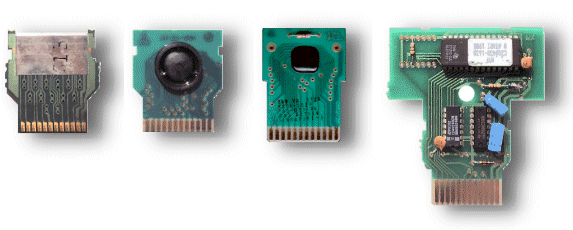|
|
 |
|
|
home site news atari news atari glossary atari history atari video game systems > atari 2600 > technical specs > pcb-layout > cartridge tech > hardware > software > collection > specials > atari 5200 > atari 7800 > atari lynx > atari jaguar 64 > atari jaguar CD > atari xegs atari computers atari coin-op atari stand-alone-systems atari library atari theater atari links legal stuff/imprint contact us |
Atari 2600 cartridge tech Ever wondered, what those little imprinted numbers on the the top left on some end-labels mean (inside the red square)? Well, it's quite easy: the first two digits tell us the WEEK of production, the third digit tells the YEAR of production, i.e. this 'Asterix' (PAL version) was manufactured in the 47th week of 1983. Yet unknown is the meaning of the letter behind the production-date. If anyone knows, please inform us.
These are different (EP)ROM-types used in VCS cartridges. From left to right: 1.
'normal' ROM with electric shielding, taken from Atari's 'Adventure' The '32 in 1' is quite special: besides the 'TMS27C512', a 64Kbytes (512 divided by 8) EPROM by Texas Instruments, there are several other components on the PCB: 1.
one binary counter (left one of the two small chips) The 64K EPROM holds the 32 games (2K each). The binary counter is responsible for selecting, i.e. counting which game is currently selected by switching the VCS 'Off' and 'On' again. The big capacitors (blue) keep an electric charge to help the binary counter memorize its current value. The small capacitors (brown) are smoothing out the power going to the ICs. The are known versions of '32 in 1' with a ROM instead of an EPROM...do you know why? Tell us!
|
|
|
Contents and pictures © 1999 - 2026 by 'www.atarihistory.de' unless otherwise noticed |



